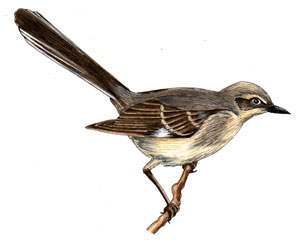 |
Mockingbirds are renown for their ability to mimic the songs of other songbirds. They serenade the neighborhood for hours in the spring and summer, often at night by the light of a full moon or nearby street light, probably because of the hormonal changes that accompany mating and nesting during this time. Mockingbirds can master 180 calls and more than 400 song types in a few months. Their own call is a musical burble punctuated with an occasional harsh tone.
Originally natives of open scrub pine and oak forests of the West and Southeast, mockingbirds have edged northward over the last 30 years. They developed an affinity for mowed lawns and ornamental shrubs that offer them insects and berries they love to eat. They are very comfortable around people. They now range from parts of southern Canada to southern Mexico. Some mockers, typically those in the west, and in the northern most part of their range in Canada, migrate toward warmer regions south or to the coast. The Mockingbird is the state bird of Texas, Florida, Arkansas, Tennessee and Mississippi. Mockingbirds will live 4 to 12 years.
Recognizing Northern Mockingbirds (Mimus polyglottos)
Mockingbirds are relatives of catbirds and thrashers, grouped as "mimic thrushes". They are about 11 inches long -- the size of a robin but a bit thinner. Both sexes look alike. They are soft gray with paler breasts, marked with white wing bars and outer tail feathers. White patches under their wings are visible when they fly. They have long, thin beaks and long perky tails.
Unlike many small birds that spend every waking hour looking for food, mockingbirds take time to survey the passing world. From their preferred high perch on a roof or tree branch they trill their varied songs, flicking their long tails, wren-like, every so often. They are acrobatic fliers and feisty combatants when it seems like a good idea to harass neighborhood cats, dogs, squirrels other birds and wildlife to protect their territory.
Mockingbirds love just about any fruiting shrub or tree, many of which you are likely to have in your yard already. Honeysuckle, a hedge of privet, dogwood, cherry trees and eleagnus are staples of many home landscapes. To attract mockers and encourage these otherwise cheerful birds to visit your yard, try planting:
In the eastern part of the United States
| Eastern Plants Loved by Mockingbirds | |||
|---|---|---|---|
| Bayberry | Chinaberry | hawthorn | redcedar |
| Beautyberry | crabapple | holly | sassafras |
| Bittersweet | greenbrier | juniper | serviceberry |
| Blackberry | elder | mulberry | viburnum |
| Blackgum | elderberry | palmetto | Virginia Creeper |
| Black cherry | hackberry | pyracantha | winterberry |
In the southwest:
| Plants In Southwest | |||
|---|---|---|---|
| Blackberry | condalia | holly | Virginia creeper |
| Bluewood | hackberry | ehretia | |
On the west coast:
| Plants On West Coast | |||
|---|---|---|---|
| Bearberry | California peppertree | elderberry | laurel |
| Blackberry | Cascara | fig | nightshade |
| Buckhorn | cedar | grape | |

